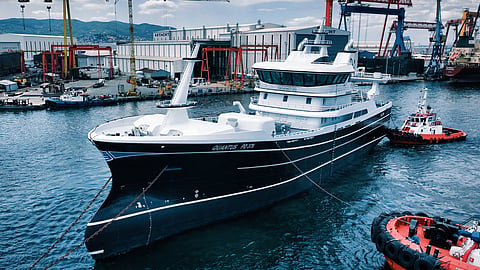VESSEL REVIEW | Quantus – New pelagic trawler to be deployed in North Atlantic off Scotland
Norse Shipyard in Turkey has handed over a new trawler to Scotland-based fishing company Quantus.
The newbuild, which is also named Quantus, was designed by Norwegian naval architecture firm Salt Ship Design.
The owner’s main focus during the design process has been to develop an efficient, modern pelagic trawler with low emissions, a safe work platform, and high fish quality to enable skippers Ian, Mark and Stuart Buchan and their crew to catch their quota as efficiently and safely as possible.
“It stands out with its advanced fishing and processing systems, optimised hull form for efficiency, and sustainable operational capabilities,” Aysu Hilal Girgin, Business Development Engineer at Norse Shipyard, told Baird Maritime. “The vessel was developed in close collaboration with industry experts, skippers, and crew to ensure it meets the demanding conditions of North Atlantic fisheries.”
Flexible propulsion setup coupled with full deck and fishing equipment suite
Girgin said the owner required a highly efficient trawler capable of operating in demanding North Atlantic conditions. Key requirements included high-capacity fishing equipment, modern processing systems, optimal fuel efficiency, and a safe, ergonomic working environment for the crew. Once in operation, the vessel will focus on catching pelagic fish species such as herring and mackerel.
The DNV-classed vessel has a length of 76.46 metres (250.9 feet), a beam of 15.8 metres (51.8 feet), a depth of 9.3 metres (31 feet), and a steel hull.
The owner requested that the vessel be constructed within a short timeframe, and Norse Shipyard contributed as a partner in the construction, supporting Norwegian counterpart Westcon Yards. Norse was responsible for the hull and the installation of some of the key equipment while Westcon undertook final outfitting.
Quantus is equipped with a diesel propulsion system that includes Brunvoll’s proprietary propulsion and thruster control system, an aft tunnel thruster, and a retractable azimuthing thruster in the bow.
“This setup balances efficiency and power, making it well-suited for demanding pelagic fishing operations in the North Atlantic,” said Girgin.
“In addition, an antenna mast is arranged according to the GA plan for navigation and communication equipment. All cable trays, lights, antennae, and devices are designed for safe and easy access, wash-down, and maintenance.”
This means all mast-mounted equipment can be accessed without the need for ladders or long-reach tools. Spare cable pipes are arranged for future upgrades, giving the vessel flexibility for new technologies.
Girgin said the combination of X-band and S-band radars provides both high-resolution short-range detection and long-range capability, ensuring safe navigation under all conditions. For fishing operations, the inclusion of advanced sonar helps make trawling more efficient.
“Quantus is fitted with high-capacity winches, cranes, and net-handling systems designed for rapid deployment and retrieval during pelagic fishing,” Girgin told Baird Maritime.
“[The vessel] features a fully equipped deck system supporting pelagic fishing, mooring, towing, and safety operations. Key elements include anchor and mooring winches, trawl and auxiliary winches, tailend and lifeline handling gear, net drums, hose reels, lifting cranes, and davits.”
The retractable azimuthing thruster functions as a tunnel thruster in the raised position and as a manoeuvring and propulsion unit when lowered. This allows for precise manoeuvring in port and during fishing operations.
It also provides additional thrust as needed, helps maintains course in challenging sea conditions, reduces fuel consumption (by minimising inefficient use of the rudder and the main propulsion), and prevents interference with fishing gear.
The propulsion system also integrates advanced control technology to optimise fuel efficiency without compromising power, enhancing both operational performance and safety.
“The vessel is equipped with a comprehensive navigation and searching system. This includes one ARPA X-band radar and one ARPA S-band radar with dedicated foundations and platforms with railings for safe maintenance. For underwater searching, the setup consists of sonar systems, an echosounder, a Doppler current meter, a speed log, and a wireless trawl surveillance system.”
Pre-outfitting and prefabrication to streamline construction
Safety and accessibility are ensured with ladders, anti-skid surfaces, liferafts, and MOB boat davits. Exhaust and SCR systems are integrated on deck to meet IMO Tier III standards, while navigation and signal lights, including Xenon searchlights, complete the setup.
The deck equipment setup is designed for operational efficiency, safety, and flexibility. In particular, prefabricated foundations and piping reduce installation time and allow precise block lifting.
The onboard processing plant is meanwhile laid out to ensure high throughput while maintaining product quality, featuring energy-efficient refrigeration and storage systems.
“A key challenge during the detail design phase was fitting large, advanced fishing and processing equipment into the vessel’s limited internal space,” said Girgin. “Additional challenges included optimising the hull for fuel efficiency and creating a safe and ergonomic working environment for the crew.”
Given the short delivery schedule with completion set for May 2025, the construction process had to be carefully planned and executed with maximum efficiency.
“One of the biggest challenges was the lifting and installation of a 120-ton block during the erection phase, while another was the installation of 48 pieces of engine room equipment within just two days, culminating with the precise placement of the main engine. These heavy-lift and precision-fit operations required meticulous planning, close teamwork, and careful sequencing to ensure safety, efficiency, and adherence to the timeline.
To minimise additional work during slipway assembly, as many units as possible were fully outfitted during the block prefabrication stage, including RSW hold cladding and associated piping.
“The project demonstrated the value of precise pre-outfitting, efficient logistics planning, and effective communication between design and production teams,” Girgin told Baird Maritime. “These methods will be carried forward to improve efficiency in future builds.”


